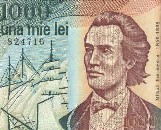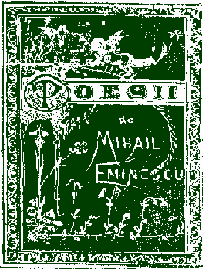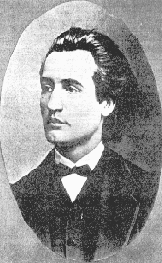The poet Mihai Eminescu (1850-1889) is probably the most disputed character in Romanian culture, especially owing to post-Communist reforms in education. In the old school textbooks, he was described as "the national poet," "the most important figure in Romanian culture," "the unmatched poet" and "the star of universal spirituality." Needless to say, his work was considered to be above any kind of critical research.
That is why the recent volume (edited by the publishing house Polirom), Dulcea mea Doamnă / Eminul meu iubit: Corespondenţă inedită Mihai Eminescu - Veronica Micle (My Sweet Lady / My Beloved Emin: Previously Undiscovered Correspondence between Mihai Eminescu and Veronica Micle, 2000), containing 93 of Eminescu's letters to his lover Veronica Micle (1850-1889) and 15 of her replies—all published for the very first time—has sparked new debate and controversy.
Eminescu's short, tragic life has long been considered a good match for his Romantic poetical work. He was born in 1850 in Ipoteşti, a village situated in the west of Moldova. His wealthy father sent him to study philosophy, law and history at the universities of Vienna and Berlin, but he never graduated from either of them. After returning to Romania in 1874, Eminescu settled in Iaşi (the major Moldavian city), where he served as the director of the Central Library and later as a school inspector. In 1877, he moved to Bucureşti and worked as a political journalist for Timpul (the official journal of the Conservative Party).
The lovers meet
Eminescu met Veronica Micle while he was in Iaşi—or, according to some historians, still a student in Vienna. Veronica was a member of the local bourgeoisie, the wife of a much older man and mother of two daughters. An active figure in society life, she hosted a literary salon and wrote poetry and short stories herself.
Veronica's romance with Eminescu started some ten months before her husband's death in 1879.[1] Veronica was thrilled to become "the official muse" of the poet, who was not only very famous, but also a romantic lover, showering her with flowers and poetry. However, their relationship—which came to an end in 1883—was a complicated one, as they lived in different cities and were not able to see each other for months at a time.
 |
| Eminescu depicted on 1000 lei note |
In June 1883 (four months after his last letter to Veronica), Eminescu had a violent nervous breakdown. He was admitted to a psychiatric institution, and spent the rest of his life between hospitals and friends' houses. His colleagues organised public fundraisers and sent him to expensive sanatoriums in Vienna and Italy. Short periods of recovery and then violent attacks of mental disease followed. He was eventually found dead on a hospital bed on the morning of 15 June 1889.
His death is, in itself, a subject of controversy. According to the death certificate, he suffered from a hereditary manic-depressive psychosis, a disease that would account for his sudden changes of temper;[2] the sickness was aggravated by alcohol abuse and overdoses of mercury (frequently used for therapeutic purposes at the time). However, his sister claimed that he was, in fact, afflicted with syphilis—a disease he had contracted years before, while still a student, and which eventually affected his nervous system.[3]
Eminescu never kept a diary. His biography has been reconstructed from the accounts of his contemporaries —accounts that often contradict each other. Some described him as a solitary man, a melancholic figure, always living in poverty, always tormented and absent-minded—a daydreamer and a visionary. Others claimed that he was, to the contrary, a man with a rich social life, a funny, even talkative character, who enjoyed beautiful ladies and good wines, going to parties and dancing, and who "wore the cutaway elegantly."[4]
Love letters published a century later
Eminescu's letters are therefore priceless for literary historians, offering a chance to better understand Eminescu's real personality. As for the letters published for the first time in this volume, they are a big surprise in themselves. Veronica Micle left them to her daughter, who in turn passed them on to her own daughter, Graziella Grigorcea, living in Italy. The great-granddaughter of Veronica (Anna Maria Grigorcea-Messeri) inherited the letters. A family friend had tried to convince her for years to publish the documents. After 1990, she finally agreed.
While reading these pages, one has the feeling of violating a very private thing, because the letters were never meant to be published. They are not literary works, but just the usual kind of intimate letters between lovers. The relationship between Eminescu and Veronica seems to have the intensity of teenage love.
Inflamed, passionate words of love are followed by very practical considerations about money, mutual acquaintances and even political matters. After a fight, they address each other in a very cold manner as "Lady" and "Mr Eminescu" and accuse each other of being insensitive, unfaithful and cruel. After they reconcile, they write about eternal love and marriage.
The Romantic ethos
The Romantic ethos of the letters is undoubtedly owing to the sentimental culture of the time. Eminescu writes:
Veronica, sweet Veronica, the moment you stop loving me, I will die… You gave me golden days… you are the God to whom I pray.[5]
One can find here echoes of Eminescu's German and French reading—influences from Lamartine, Musset, Schiller and Heine. After all, both lovers were highly interested in literature. Reading and real feelings are so mixed for them that Eminescu even seems to fear a change in their relationship when Veronica turns to the new Realist authors: "I embrace you, reader of Zola, and ask you to throw away these books."[6]
It is also true that Eminescu's letters abound in descriptions of a rather erotic nature; he yearns to touch and kiss his lover with the same fervour as that expressed in the poems he dedicated to her:
Forehead pale and tresses golden
On my shoulder you incline,
And your lip's [sic] delicious plunder
Raise up willingly to mine.[7]
 |
| A collection of Eminescu's poetry |
Why Eminescu and Veronica never married
After all, what stopped them from getting married, as they were planning? It was claimed that Titu Maiorescu, a major critic and prominent political figure of the time, who was also Eminescu's protector, had prevented him from marrying Veronica because "he wouldn't cry so beautifully anymore."[10] However great Maiorescu's influence upon Eminescu, it is hard to believe that this was the real reason. Instead, the letters suggest three other possible explanations.
First, Eminescu does not trust Veronica enough: "Forgive me, but whenever you tell me about your suitors, you make my heart ache."[11] It is true that she consciously fuels his jealousy in an attempt to make herself more desirable in his eyes. She tells him about the men chasing her and about her latest haircuts or fashion acquisitions.
I wanted to make some changes, so I cut my hair á la Vienoise and I dress it every day, finally I bought a Néniche hat and Louis XV boots and some other trifles, there is only one thing that bothers me—it is extraordinarily cold in Iaşi, and I cannot go for walks when I choose.[12]
Second, Eminescu fears that he is not able to support a wife and two children financially:
You ask me when we will be united forever. I answer you: as soon as possible. I only want you to consider whether this "official" union is feasible, unless my position is reasonably secured.[13]
Last, but not least, it seems that Eminescu avoids domestic happiness because he prefers to keep Veronica as an ideal image, a muse both desired and beyond human reach. He speaks of "being doomed" and finds strange pleasure in condemning his own feelings: "Isn't our love an abnormality in the world's state of things, an abnormality for which they try to punish us?"[14]
The blending of life and literature
Veronica's letters are far more self-conscious. Being a poetess herself, she values her lover's celebrity and talent. She writes in either Romanian or French and—despite some embarrassing grammar mistakes—tries to match her cultivated lover. Her phrases are sometimes over-constructed, with a rhetoric borrowed from the French romances of the time. Interestingly enough, besides a few pet names, she generally addresses him as "Eminescu," or "Emin" or even "Miguel Eminescu de Ipoteşti"[15] and never uses his first name. Veronica is so proud of her famous lover that she even shows his letters to others:
I read some of your letters to a lady, and told her: let anyone weigh whether Eminescu would write to me like that, if my detractors were speaking at least a shadow of truth.[16]
She seeks his advice concerning her own works: "I have started writing the short story 'Kollah-Mob'—what ending do you advise me to put to it, a sad one or a happy one?"[17]
Sometimes, Veronica seems to confuse Eminescu the poet and Eminescu the lover to such an extent that she even signs some of her letters with the name of one of his heroines. He, in turn, questions her feelings:
Maybe you wouldn't have loved me at all, if it weren't for this extraordinary thing in my life, which is, at the same time, an extraordinary misfortune.[18]
Controversy is sparked
Vows and reproaches; passion and coldness; gossip and complaints… Beyond the trivial details, the volume is valuable for yet another reason. During Communism, and especially so-called National Communism (between 1965 and 1989, under the rule of Ceauşescu), Eminescu was mythologized as the "national poet," partly because of his nationalist poems and the political articles he published in Timpul,[19] and partly because Ceauşescu constructed a symbolic "genealogy" for himself which consisted of major historical figures, including Eminescu. It was not until the end of the 1980s, on the centenary of Eminescu's death, that critics spoke for the first time about "the case of Eminescu."

|
A huge media scandal ensued. "Traditionalist" critics (Alex Ştefănescu, George Pruteanu, Adrian Păunescu and Eugen Simion) found this kind of criticism to be outrageous and held that it endangered the very fibre of the Romanian nation and Romanian cultural identity. The pros and cons were discussed in dozens of books, hundreds of articles, as well as on TV and radio shows.
This volume reopens the conflict. Laurenţiu Ulici, the president of the Writers' Union, questioned the authenticity of the letters[21] and said that even if they were genuine, they should not have been made available for the general public. Others were thrilled to discover Eminescu's human faults and to hunt his offensive remarks on Jews, Greeks and so on.
Authentic or not, despite its high price of ROL (Romanian leu) 440,000 (USD 18)—about 20 per cent of the average Romanian monthly wage—this collection of Eminescu's love letters has become a bestseller.
Emilia Stere, 9 October 2000
Moving on:
- Book review archive
- Browse through the CER eBookstore for electronic books
- Buy English-language books on Romania through CER
- Return to CER front page
Footnotes:
2. Mircea Cărtărescu, "Fapte," Dilema 265 (27 Feb-5 March 1998): 9.
4. Alexandru Paleologu, "Imaginile succesive," Dilema 265 (27 Feb-5 March 1998): 16.
7. "Longing," translated by Corneliu M Popescu, "Discovering Eminescu" Website.
10. Dan C Mihăilescu, "Sublimul de pamânt," 22 issue 31 (1-7 August 2000): 15.
20. Issue 265 (27 Feb-5 March 1998).



